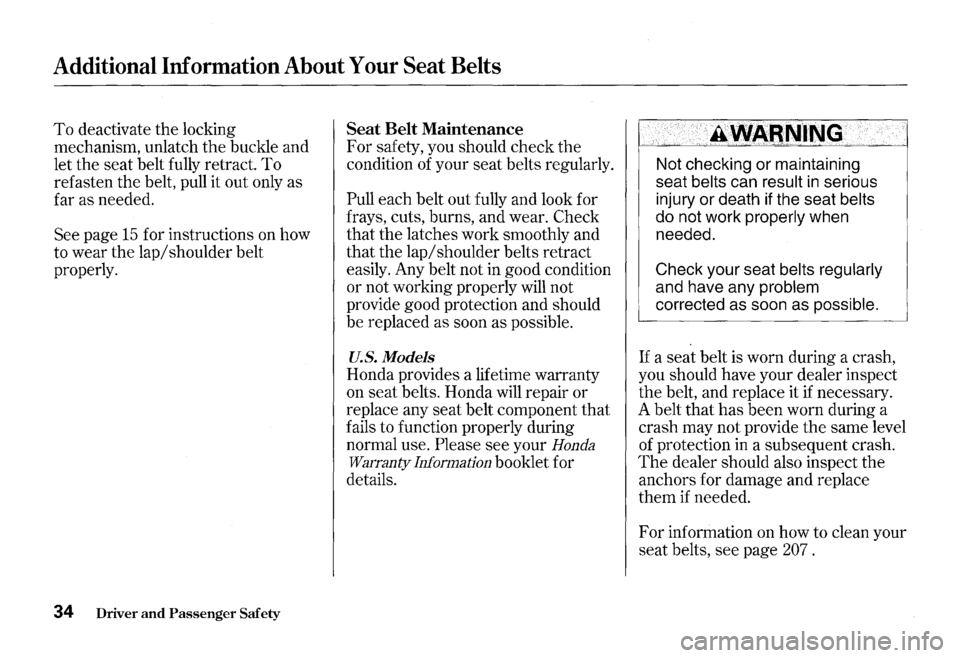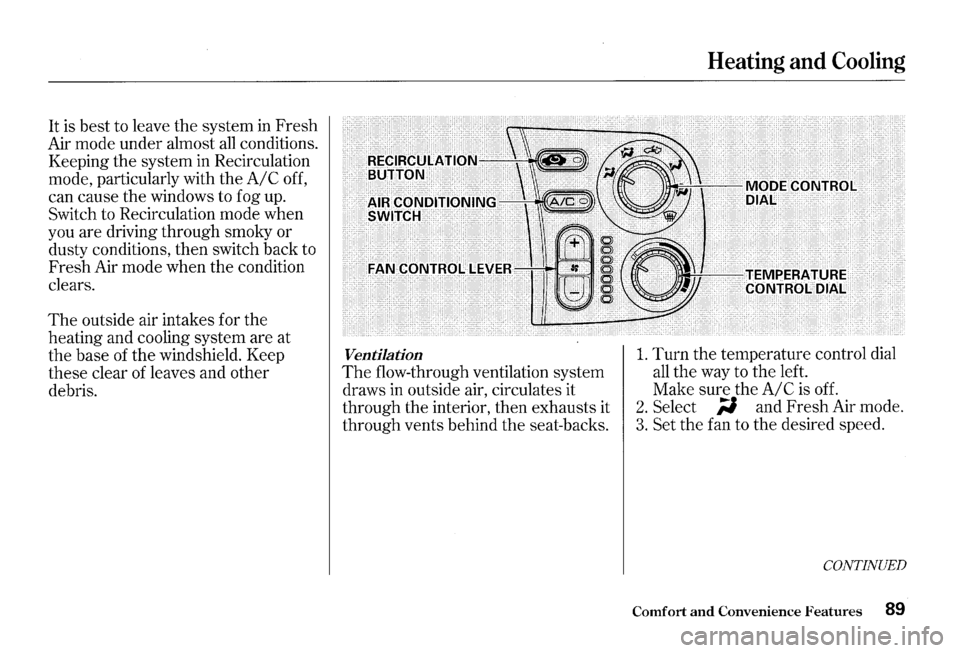2000 HONDA S2000 air condition
[x] Cancel search: air conditionPage 9 of 273

Important Safety Precautions
You'll find many safety
recommendations throughout this
section, and throughout this manual.
The recommendations on this page
are the ones we consider to be the
most important.
Always WearY our Seat Belt
A seat belt is your best protection in
all types of collisions. Airbags
supplement seat belts, but airbags
are designed to inflate only
in a
moderate to severe frontal collision.
So even though your car is equipped
with airbags, make sure you and
your passenger always wear your
seat belts, and wear them properly.
(See page
15 ) .
Your Car is Not Recommended
for Child Passengers
Since all children are safest in the
back seat of a car, and your car does
not have a back seat, we recommend
that you
do not carry a child
passenger.
Due to the passenger's
6 Driver and Passenger Safety
airbag hazard, you should never
carry an infant in a rear-facing child
seat in this car. If a small child who
must be restrained in a forward
facing child seat, or a larger child,
must ride
in this car, be sure to
follow
all instructions and safety
warnings
in this manual. (See pages
26 and 29.)
Be Aware of Airbag Hazards
While airbags can save lives, they
can cause serious or fatal injuries to
occupants who sit too close to them,
or are not properly restrained.
Infants, young children, and short
adults are at the greatest
risk Be
sure to follow
all instructions and
warnings
in this manual. (See page
7 .)
Don't Drink and Drive
Alcohol and driving don't mix. Even
one drink can reduce your ability to
respond to changing conditions, and
your reaction time gets worse with every
additional
drink So don't drink
and drive, and don't let your friends
drink and drive, either.
Control Your Speed
Excessive speed is a major factor in
crash injuries and deaths. Generally,
the higher the speed the
greater the
risk, but serious accidents can also
occur
at lower speeds. Never drive
faster than is safe for current
conditions, regardless of the
maximum speed posted.
Keep Your Car in Safe Condition
Having a tire blowout or a
mechanical failure can be extremely
hazardous.
To reduce the possibility
of such problems, check your tire
pressures and condition frequently,
and perform
all regularly scheduled
maintenance. (See page 146
.)
Page 37 of 273

Additional Information About Your Seat Belts
To deactivate the locking
mechanism, unlatch
the buckle and
let the seat belt fully retract.
To
refasten the belt, pull it out only as
far as needed.
See page
15 for instructions on how
to wear the lap/shoulder belt
properly.
34 Driver and Passenger Safety
Seat Belt Maintenance
For safety, you should check the
condition of your seat belts regularly.
Pull each belt out fully and look for
frays, cuts, burns, and wear. Check
that the latches work smoothly and
that the lap/shoulder belts retract
easily. Any belt not
in good condition
or not working properly will not
provide good protection and should
be replaced as soon as possible.
U.S. Models
Honda provides a lifetime warranty
on seat belts. Honda
will repair or
replace any seat belt component
that
fails to function properly during
normal use.
Please see your Honda
WmTanty Information
booklet for
details.
·.
Not checking or maintaining
seat
belts can result in serious
injury or death if the seat
belts
do not work properly when
needed.
Check your seat
belts regularly
and have any problem
corrected as soon as possible.
If a seat belt is worn during a crash,
you should have your dealer inspect
the belt, and replace it
if necessary.
A belt that
has been worn during a
crash may not provide
the same level
of protection in a subsequent crash.
The dealer should also inspect the
anchors for damage and replace
them if needed.
For information on how to clean your
seat belts, see page
207 .
Page 42 of 273

Your car's exhaust contains carbon
monoxide gas.
You should have no
problem with carbon monoxide
entering the car in normal driving
if
you maintain your car properly.
Have the exhaust system inspected
for leaks whenever:
• The car is raised for an oil change.
• You notice a change in the sound
of
the exhaust.
• The car was in an accident that
may have damaged the underside.
Carbon monoxide gas is toxic.
Breathing it can cause
unconsciousness and even
kill
you.
Avoid any
enclosed areas or
activities that expose you to
carbon monoxide.
High levels of carbon monoxide can
collect rapidly in enclosed areas,
such as a garage. Do not run the
engine with the garage door closed.
Even with the door open, run the
engine only long enough to move the
car out of the garage.
Carbon Monoxide Hazard
With the trunk lid open, air flow can
pull exhaust gas into your vehicle's
interior and create a hazardous
condition.
If you must drive with the
trunk lid open, open
all the windows
and set the heating and cooling
system as shown below.
If you must sit in your parked car,
even
in an unconfined area, with the
engine running, adjust the heating
and cooling system as follows:
1. Push the ~ button.
2. Select the w mode.
3. Turn the fan on high speed.
4. Set the temperature control to a
comfortable setting.
Driver and Passenger Safety 39
Page 88 of 273

Comfort and Convenience Features
The heating and air conditioning
systems
in your Honda provide a
comfortable driving environment
in
all weather conditions.
The standard audio system has
many features. This section de
scribes those features and how to
use them.
(If you selected an
optional audio system, refer to the
operating instructions that came
with it.) Heating
and Cooling ........................ 86
What Each Control Does ............
86
How to Use the System ............... 88
To Turn Everything Off ............. 93
Audio System
AM/FM/CD Audio System ....... 94
Operating the Radio .................... 95
Adjusting the Sound .................... 99
Audio System Lighting ............. 100
Radio Frequencies ..................... 100
Radio Reception ......................... 101
Operating the CD Player .......... 102
Operating the CD Changer ...... 107
Protecting Compact Discs ........ 108
CD Player Error Indications ..... 110
CD Changer Error
Indications ..............................
111
Remote Audio Controls ............ 112
Theft Protection ........................ 113
Comfort and Convenience Features 85
Page 89 of 273

Heating and Cooling
Proper use of the Heating and
Cooling system can make the
interior dry and comfortable, and
keep the windows clear for best
visibility.
What Each Control Does
Fan Control Lever
Pushing this lever up and down
increases and decreases
the fan
speed.
The indicators next to the
lever show you the speed selected.
Temperature Control Dial
Turning this dial clockwise increases
the temperature of the air
flow.
Air Conditioning (A/C) Button
This button turns the air condi
tioning
ON and OFF. The indicator
in the button lights when theA/Cis
on.
86 Comfort and Convenience Features
Recirculation Button
This button controls the source of
the air going into the system. When
the indicator
in this button is lit, air
from the car's interior is sent
through the system again (Recircula
tion mode). When the indicator is off,
air
is brought in from outside the car
(Fresh Air mode).
Page 91 of 273

Heating and Cooling
Vent Controls
You can adjust the direction of the
air coming from the vents on both
sides of the instrument panel and at
the corner of the dashboard on the
passenger's side.
To adjust the air
flow up and down, move the tab
in
the center of each vent up and down.
To adjust it left and right, turn the
dial under each vent left and right.
88 Comfort and Convenience Features
You can shut off the air flow from
each vent by turning the dial
all the
way toward the
t>UO mark until it
clicks. How
to Use the System
This
section covers how to set up the
system controls for ventilation,
heating, cooling, dehumidifying, and
defrosting.
The engine must be running for the
heater and air conditioning to
generate hot and cold air.
The heater
uses engine coolant to warm the air.
If the engine is cold, it will be several
minutes before you feel warm air
coming from the system.
The air conditioning does not rely on
engine temperature.
Page 92 of 273

It is best to leave the system in Fresh
Air mode under almost all conditions.
Keeping
the system in Recirculation
mode, particularly with
the A/C off,
can cause
the windows to fog up.
Switch to Recirculation mode when
you are driving
through smoky or
dusty conditions,
then switch back to
Fresh Air mode when the condition
clears.
The outside air intakes for the
heating and cooling system are at
the base of the windshield. Keep
these clear of leaves and other
debris.
Ventilation
The flow-through ventilation system
draws in outside air, circulates it
through
the interior, then exhausts it
through vents behind
the seat-backs.
Heating and Cooling
1. Turn the temperature control dial
all
the way to the left.
Make sure
theA/Cis off.
2. Select ;J and Fresh Air mode.
3. Set the fan to the desired speed.
CON11NUED
Comfort and Convenience Features 89
Page 93 of 273

Heating and Cooling
To Cool with A/C
1. Turn on the AI C by pressing the
button.
The light in the button
should come on when a fan speed
is selected.
2. Make sure the temperature
control dial is
all the way to the left.
3. Select ;,; .
4. If the outside air is humid, select
Recirculation mode.
If the outside
air is dry, select Fresh Air mode.
Set
the fan to the desired speed.
If the interior is very warm from
being parked
in the sun, you can cool
it down more rapidly by setting up
the controls this way:
1. Start the engine.
2. Turn on the A/C by pressing the
button. Make sure the tempera
ture control dial is
all the way to
the left.
3. Set the fan to maximum speed.
4. Open the windows partially. Select
;,; and Recirculation mode.
90 Comfort and Convenience Features
When the interior has cooled down
to a more comfortable temperature,
close the windows and set the
controls as described for normal
cooling. Air
conditioning places an extra load
on the engine. Watch the engine
coolant temperature gauge (see page
47) when driving in stop-and-go
traffic or climbing a long, steep hill.
If it moves near the red mark, turn
off the
A/ C until the reading returns
to normal.